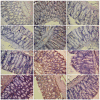Shugan-decoction relieves visceral hyperalgesia and reduces TRPV1 and SP colon expression
- PMID: 24307802
- PMCID: PMC3848156
- DOI: 10.3748/wjg.v19.i44.8071
Shugan-decoction relieves visceral hyperalgesia and reduces TRPV1 and SP colon expression
Abstract
Aim: To evaluate the therapeutic effect of Shugan-decoction (SGD) on visceral hyperalgesia and colon gene expressions using a rat model.
Methods: Ninety-six adult male Wistar rats were randomized into six equal groups for assessment of SGD effects on psychological stress-induced changes using the classic water avoidance stress (WAS) test. Untreated model rats were exposed to chronic (1 h/d for 10 d consecutive) WAS conditions; experimental treatment model rats were administered with intragastric SGD at 1 h before WAS on consecutive days 4-10 (low-dose: 0.1 g/mL; mid-dose: 0.2 g/mL; high-dose: 0.4 g/mL); control treatment model rats were similarly administered with the irritable bowel syndrome drug, dicetel (0.0042 g/mL); untreated normal control rats received no drug and were not subjected to the WAS test. At the end of the 10-d WAS testing period, a semi-quantitative measurement of visceral sensitivity was made by assessing the abdominal withdrawal reflex (AWR) to colorectal balloon-induced distension (at 5 mmHg increments) to determine the pain pressure threshold (PPT, evidenced by pain behavior). Subsequently, the animals were sacrificed and colonic tissues collected for assessment of changes in expressions of proteins related to visceral hypersensitivity (transient receptor potential vanilloid 1, TRPV1) and sustained visceral hyperalgesia (substance P, SP) by immunohistochemistry and real-time polymerase chain reaction. Inter-group differences were assessed by paired t test or repeated measures analysis of variance.
Results: The WAS test successfully induced visceral hypersensitivity, as evidenced by a significantly reduced AWR pressure in the untreated model group as compared to the untreated normal control group (190.4 ± 3.48 mmHg vs 224.0 ± 4.99 mmHg, P < 0.001). SGD treatments at mid-dose and high-dose and the dicetel treatment significantly increased the WAS-reduced PPT (212.5 ± 2.54, 216.5 ± 3.50 and 217.7 ± 2.83 mmHg respectively, all P < 0.001); however, the low-dose SGD treatment produced no significant effect on the WAS-reduced PPT (198.3 ± 1.78 mmHg, P > 0.05). These trends corresponded to the differential expressions observed for both TRPV1 protein (mid-dose: 1.64 ± 0.08 and high-dose: 1.69 ± 0.12 vs untreated model: 3.65 ± 0.32, P < 0.001) and mRNA (0.44 ± 0.16 and 0.15 ± 0.03 vs 1.39 ± 0.15, P < 0.001) and SP protein (0.99 ± 0.20 and 1.03 ± 0.23 vs 2.03 ± 0.12, P < 0.01) and mRNA (1.64 ± 0.19 and 1.32 ± 0.14 vs 2.60 ± 0.33, P < 0.05). These differential expressions of TRPV1 and SP related to mid- and high-dose SGD treatments were statistically similar to the changes induced by dicetel treatment. No signs of overt damage to the rat system were observed for any of the SGD dosages.
Conclusion: Shugan-decoction can reduce chronic stress-induced visceral hypersensitivity in rats, and the regulatory mechanism may involve mediating the expressions of TRPV1 and SP in colon tissues.
Keywords: Shugan-decoction; Substance P; Sustained visceral hyperalgesia; Transient receptor potential vanilloid 1; Visceral hypersensitivity; Water avoidance stress.
Figures

Similar articles
-
Alterations in serotonin, transient receptor potential channels and protease-activated receptors in rats with irritable bowel syndrome attenuated by Shugan decoction.World J Gastroenterol. 2015 Apr 28;21(16):4852-63. doi: 10.3748/wjg.v21.i16.4852. World J Gastroenterol. 2015. PMID: 25944998 Free PMC article.
-
The vanilloid receptor initiates and maintains colonic hypersensitivity induced by neonatal colon irritation in rats.Gastroenterology. 2007 Feb;132(2):615-27. doi: 10.1053/j.gastro.2006.11.014. Epub 2006 Nov 10. Gastroenterology. 2007. PMID: 17258716
-
[Effect of moxibustion of "dachangshu" (BL 25) area on pain reaction and TRPV 1 mRNA expression of bone marrow cells in visceral hyperalgesia rats].Zhen Ci Yan Jiu. 2013 Feb;38(1):14-9. Zhen Ci Yan Jiu. 2013. PMID: 23650794 Chinese.
-
Systematic Review on Herbal Preparations for Controlling Visceral Hypersensitivity in Functional Gastrointestinal Disorders.Curr Pharm Biotechnol. 2024;25(13):1632-1650. doi: 10.2174/0113892010261502231102040149. Curr Pharm Biotechnol. 2024. PMID: 38258770
-
Visceral pain hypersensitivity in functional gastrointestinal disorders.Br Med Bull. 2009;91:123-36. doi: 10.1093/bmb/ldp026. Epub 2009 Jul 19. Br Med Bull. 2009. PMID: 19620136 Review.
Cited by
-
Metagenomics and metabolomics analysis to investigate the effect of Shugan decoction on intestinal microbiota in irritable bowel syndrome rats.Front Microbiol. 2022 Nov 21;13:1024822. doi: 10.3389/fmicb.2022.1024822. eCollection 2022. Front Microbiol. 2022. PMID: 36478867 Free PMC article.
-
Alterations in serotonin, transient receptor potential channels and protease-activated receptors in rats with irritable bowel syndrome attenuated by Shugan decoction.World J Gastroenterol. 2015 Apr 28;21(16):4852-63. doi: 10.3748/wjg.v21.i16.4852. World J Gastroenterol. 2015. PMID: 25944998 Free PMC article.
-
Shaoyao-Gancao Decoction Relieves Visceral Hyperalgesia in TNBS-Induced Postinflammatory Irritable Bowel Syndrome via Inactivating Transient Receptor Potential Vanilloid Type 1 and Reducing Serotonin Synthesis.Evid Based Complement Alternat Med. 2020 Oct 15;2020:7830280. doi: 10.1155/2020/7830280. eCollection 2020. Evid Based Complement Alternat Med. 2020. PMID: 33123210 Free PMC article.
-
No synergistic effect of fecal microbiota transplantation and shugan decoction in water avoidance stress-induced IBS-D rat model.Front Microbiol. 2022 Sep 12;13:995567. doi: 10.3389/fmicb.2022.995567. eCollection 2022. Front Microbiol. 2022. PMID: 36171751 Free PMC article.
-
Shugan Decoction Alleviates Colonic Dysmotility in Female SERT-Knockout Rats by Decreasing M3 Receptor Expression.Front Pharmacol. 2020 Sep 11;11:01082. doi: 10.3389/fphar.2020.01082. eCollection 2020. Front Pharmacol. 2020. PMID: 33013355 Free PMC article.
References
-
- Longstreth GF, Thompson WG, Chey WD, Houghton LA, Mearin F, Spiller RC. Functional bowel disorders. Gastroenterology. 2006;130:1480–1491. - PubMed
-
- Mulak A, Paradowski L. Anorectal function and dyssynergic defecation in different subgroups of patients with irritable bowel syndrome. Int J Colorectal Dis. 2010;25:1011–1016. - PubMed
-
- Azpiroz F, Bouin M, Camilleri M, Mayer EA, Poitras P, Serra J, Spiller RC. Mechanisms of hypersensitivity in IBS and functional disorders. Neurogastroenterol Motil. 2007;19:62–88. - PubMed
-
- Blackshaw LA, Brookes SJ, Grundy D, Schemann M. Sensory transmission in the gastrointestinal tract. Neurogastroenterol Motil. 2007;19:1–19. - PubMed
Publication types
MeSH terms
Substances
LinkOut - more resources
Full Text Sources
Other Literature Sources

